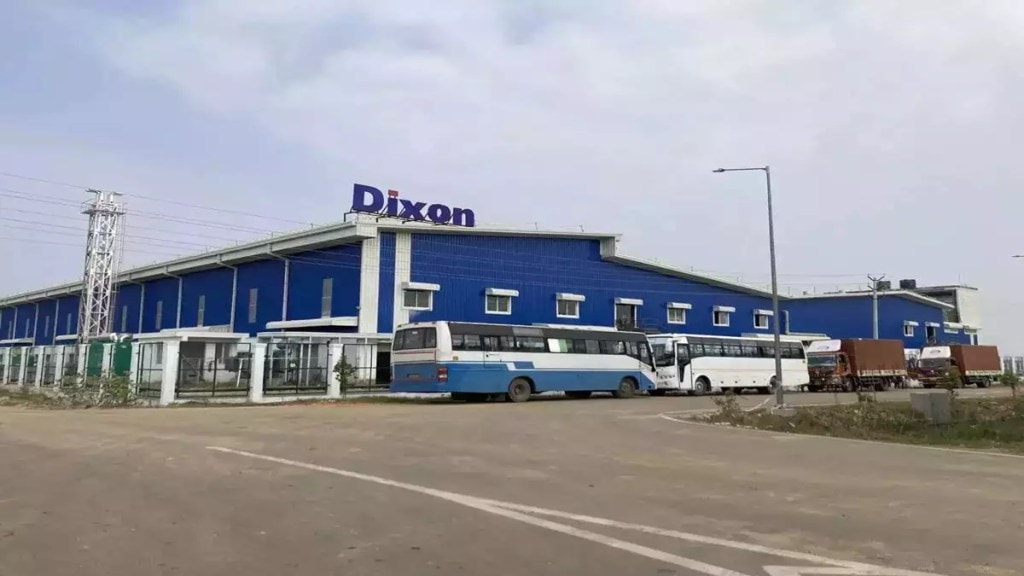The Dixon Technologies share price rose 4.5% to a high of Rs 14,954 on the National Stock Exchange. The stock has surged after the brokerage house Nomura maintained its ‘Buy’ rating on the stock and kept the target price at Rs 21,409, implying an upside of 51%.
Nomura on Dixon Technologies: Strong export tailwind
Dixon Technologies’ management remains confident of achieving 60-65 million smartphone volumes in FY27, led by the ramp-up of existing customers, strong export demand tailwinds, and approval for the Vivo JV. Of this, the company targets 13-14 million exports in FY27 (from 1.5 million in FY25) while the rest will be for the domestic market.
Motorola and Transsion are the key export drivers, and there is some potential from Vivo as well. Google still has larger sourcing from Vietnam, and a future shift would depend on India’s demand and any relatively beneficial tariffs.
Given the domestic outsourcing opportunity of 100 million units, Dixon expects to cater to only half of the industry by FY27, providing sufficient scope to grow as well. “We believe the mobile EMS industry is likely to be divided between Dixon, DBG Technology, Bhagwati, BYD, UTL Neolync, and Tata Electronics, with Dixon commanding the largest share,” said Nomura.
Component ramp-up on track
Dixon’s display module assembly with HKC (248 HK, NR) under JV should get approved soon, with production likely to start from 4QFY26E and ramp up further in FY27E, according to management. It is likely to cater to 24mn displays in the first year, ramping up to 42-43mn from the second year onwards for captive consumption. Management expects this JV to offer healthy double-digit margins and offset, to a large extent, the drag from mobile PLI being discontinued.
Camera module partnership discussions are on track and should be finalised soon, according to Dixon. It also plans to add enclosures (mainly for laptops) and Li-ion batteries as well.
These also have support from central and state governments as incentives, to the extent of investment, and is quite attractive, in our view.
Phillip Capital on Dixon Technologies: Maintains Sell
That said, another brokerage house, Phillip Capital, maintained its ‘Sell’ call on the EMS stock by slashing its target price to Rs 9,085 from Rs 11,077, implying a downside of up to 36% for the stock.
The brokerage firm noted that the company’s operations are encountering growing competition, and its biggest client, Motorola, has begun transferring domestic orders to Karbonn Mobiles, based in New Delhi.
Broaden and diversify the potential customer segments by expanding and improving the range of products offered. Keep growing the comprehensive omnichannel distribution network across India. Enhance and bolster the risk management framework, alongside underwriting and collections capabilities, to reduce the likelihood of credit losses.
Apart from that, the company’s promoter, Sunil Vachani, offloaded a 2.77% stake of the company worth Rs 2,221.3 crore through block deals on Monday.
Vachani pared 16.7 lakh shares of Dixon Technologies at an average price of Rs 13,301.47 per share. At the end of the March quarter, Vachani had a 5.34% stake in the company.
Dixon Technologies Q4 results
The company’s net profit stood at Rs 465 crore for Q4 FY25, compared with Rs 97 crore in the same quarter a year ago. The company reported a one-time exceptional gain of Rs 250.4 crore that led to a significant jump in net profit this quarter. Dixon Technologies’ revenue jumped 121% year-on-year to Rs 10,292.5 crore, which was higher than Rs 4,658 crore in the year-ago quarter.
The company’s Earnings Before Interest, Tax, Depreciation and Amortisation (EBITDA) soared 143% YoY to Rs 442.8 crore, as against Rs 182.5 crore posted in the same quarter a year ago.
Dixon Technologies’ stock performance
The share price of Dixon Technologies has risen 2.7% in the last five trading sessions. The stock has, however, declined by 2.6% in the last one month and by over 18% in the past six months. Dixon Technologies’ share price has increased investors’ wealth by almost 25% in the last one year.

